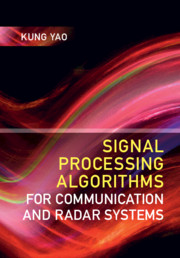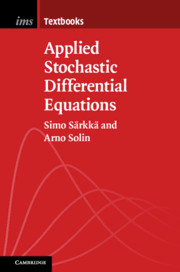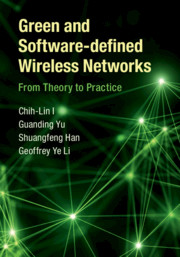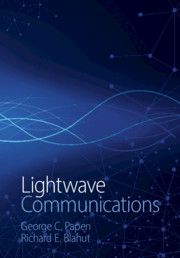Refine listing
Actions for selected content:
9096 results in Communications, Signal Processing and Information Theory
10 - Filtering and Smoothing Theory
-
- Book:
- Applied Stochastic Differential Equations
- Published online:
- 16 April 2019
- Print publication:
- 02 May 2019, pp 197-233
-
- Chapter
- Export citation
Contents
-
- Book:
- Applied Stochastic Differential Equations
- Published online:
- 16 April 2019
- Print publication:
- 02 May 2019, pp v-viii
-
- Chapter
- Export citation
8 - Numerical Simulation of SDEs
-
- Book:
- Applied Stochastic Differential Equations
- Published online:
- 16 April 2019
- Print publication:
- 02 May 2019, pp 126-164
-
- Chapter
- Export citation
Preface
-
- Book:
- Applied Stochastic Differential Equations
- Published online:
- 16 April 2019
- Print publication:
- 02 May 2019, pp ix-x
-
- Chapter
- Export citation

Signal Processing Algorithms for Communication and Radar Systems
-
- Published online:
- 25 April 2019
- Print publication:
- 02 May 2019
6 - Energy-Saving Solutions and Practices
-
- Book:
- Green and Software-defined Wireless Networks
- Published online:
- 05 April 2019
- Print publication:
- 25 April 2019, pp 252-286
-
- Chapter
- Export citation
5 - Software-Defined Air Interface (SDAI) for a Greener Network
-
- Book:
- Green and Software-defined Wireless Networks
- Published online:
- 05 April 2019
- Print publication:
- 25 April 2019, pp 182-251
-
- Chapter
- Export citation
Contents
-
- Book:
- Green and Software-defined Wireless Networks
- Published online:
- 05 April 2019
- Print publication:
- 25 April 2019, pp vii-x
-
- Chapter
- Export citation
Reviews
-
- Book:
- Green and Software-defined Wireless Networks
- Published online:
- 05 April 2019
- Print publication:
- 25 April 2019, pp i-ii
-
- Chapter
- Export citation
3 - Green and Soft Network Design
-
- Book:
- Green and Software-defined Wireless Networks
- Published online:
- 05 April 2019
- Print publication:
- 25 April 2019, pp 61-141
-
- Chapter
- Export citation
2 - Theoretical Framework toward Green Networks
-
- Book:
- Green and Software-defined Wireless Networks
- Published online:
- 05 April 2019
- Print publication:
- 25 April 2019, pp 16-60
-
- Chapter
- Export citation
List of Abbreviations
-
- Book:
- Green and Software-defined Wireless Networks
- Published online:
- 05 April 2019
- Print publication:
- 25 April 2019, pp xiii-xx
-
- Chapter
- Export citation
Index
-
- Book:
- Green and Software-defined Wireless Networks
- Published online:
- 05 April 2019
- Print publication:
- 25 April 2019, pp 287-290
-
- Chapter
- Export citation
4 - Energy-Efficient Signaling Design and Resource Management
-
- Book:
- Green and Software-defined Wireless Networks
- Published online:
- 05 April 2019
- Print publication:
- 25 April 2019, pp 142-181
-
- Chapter
- Export citation
Frontmatter
-
- Book:
- Green and Software-defined Wireless Networks
- Published online:
- 05 April 2019
- Print publication:
- 25 April 2019, pp iii-vi
-
- Chapter
- Export citation
1 - Introduction
-
- Book:
- Green and Software-defined Wireless Networks
- Published online:
- 05 April 2019
- Print publication:
- 25 April 2019, pp 1-15
-
- Chapter
- Export citation
Preface
-
- Book:
- Green and Software-defined Wireless Networks
- Published online:
- 05 April 2019
- Print publication:
- 25 April 2019, pp xi-xii
-
- Chapter
- Export citation

Applied Stochastic Differential Equations
-
- Published online:
- 16 April 2019
- Print publication:
- 02 May 2019

Green and Software-defined Wireless Networks
- From Theory to Practice
-
- Published online:
- 05 April 2019
- Print publication:
- 25 April 2019

Lightwave Communications
-
- Published online:
- 20 March 2019
- Print publication:
- 10 January 2019
-
- Textbook
- Export citation
